by Arthur Burke
Twenty-five years after the Allied landing at Normandy on 6 June 1944, another military force also crossed a start line and advanced into history at the small rubber plantation village of Binh Ba in South Vietnam.
The peaceful morning air of Phuoc Tuy Province in South Vietnam was shattered at 7.20 am by a rocket-propelled grenade (RPG) striking the turret of an Australian Centurion tank as it entered the village of Binh Ba, some six kilometres north of the Australian base at Nui Dat. Forty-eight hours later, the vicious Battle of Binh Ba concluded leaving one Australian dead and 10 wounded, but at least 107 enemy killed, six wounded and 29 detained for further investigation. This battle on 6 June 1969 was an undeniable success for the Australians and ranks as one of the major military victories of that force during the Vietnam War.

AWM MISC/69/0525/VN. Binh Ba, South Vietnam. At the rubber plantation village.
The question has often been asked, ‘Was this an ambush or an accident?’ Was the RPG fired by a nervous young local Viet Cong (VC) guerilla or a trigger-happy North Vietnamese Regular, or was this a deliberate attempt by 1st Battalion of 33rd North Vietnamese Army (NVA) Regiment to entice two Australian armoured vehicles into a trap which would draw resources away from the 6th Battalion Royal Australian Regimental (6 RAR) Group which was exerting pressure on the enemy from further north? This article tells the story of that modern D-Day battle and leaves the reader to make a decision.
The 6th Battalion had not long been in country and was still undergoing its warm-up or nursery operation which had commenced towards the end of May in an area some 17 km north of Nui Dat. Their supposedly rather benign patrolling southwards had, however, inadvertently begun to encroach upon the cross-country movement of an NVA battalion which was temporarily laying up in the former French rubber plantation village of Binh Ba. There is no doubt that it felt threatened by the hammer and anvil effect of 6 RAR pushing south towards the defended Nui Dat base.
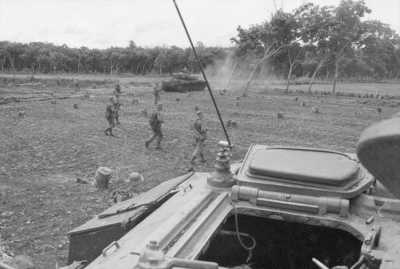
AWM BEL/69/0382/VN. Binh Ba, South Vietnam. 6 June 1969. Troops of D Company, 5th Battalion, the Royal Australian Regiment (5RAR), Commanded by Major Murray Blake, supported by Centurion tanks of B Squadron, 1st Armoured Regiment, sweep towards the edge of a rubber plantation, five miles north of the 1st Australian Task Force (1ATF) Base at Nui Dat.
The RPG which hit the replacement tank -- being accompanied to 6 RAR by an armoured recovery vehicle (ARV) -- seriously wounded the loader/operator and prevented the turret from traversing. The crew commander opened fire with a .30 calibre machine gun and was supported by the fire from two similar weapons on the ARV. The tank continued north to a nearby friendly village post whilst the recovery vehicle withdrew south to Nui Dat.
The tank’s arrival alerted the Vietnamese Regional Force (RF) Company who prepared to react against an enemy of (at that time) unknown strength. In parallel, the tank’s contact report sent by radio to the 1st Australian Task Force (1 ATF) base and a request for assistance from the Vietnamese District Chief resulted in the task force’s ready reaction force -- based on D Company 5 RAR -- being mobilised at about 9 am.
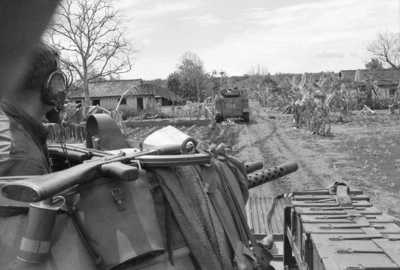
AWM BEL/69/0386/VN. Binh Ba, South Vietnam. June 1969. Commander of an armoured personnel carrier (APC) of B Squadron, 3rd Cavalry Regiment, keeps a sharp look out into a banana plantation on the roadside near Binh Ba. Australian troops inflicted heavy casualties on a North Vietnamese Army (NVA) Force which entered Binh Ba, five miles north of the 1st Australian Task Force base at Nui Dat.
Paul Stevens, a young lieutenant artillery forward observer from 105th Field Battery was attached to D Company at that time. He recalls, ‘We were ordered to move to Binh Ba, join up with a tank troop, liaise with the Vietnamese Sector Commander, and, when given the go ahead, push the VC out of the village.’ The group deployed in armoured personnel carriers (APCs) as reports from the RF company then being engaged by heavy fire in the north escalated the original estimates of an irregular enemy force of a couple of platoons. On arrival at Binh Ba, Stevens saw Vietnamese villagers being evacuated -- an obvious prelude to approval being given for the Australians’ assault -- and mused that this could be a possible escape route for some Viet Cong.
At 11.20 am, the waiting force in the east came under heavy RPG fire and the District Chief immediately told D Company commander, Major Murray Blake to ‘do what you have to do’. The import of this decision was not underrated because the inevitable collateral damage -- especially from the tanks’ 83.4 mm main armament -- to homes in the village would be substantial. The reaction force advanced, 2nd Lieutenant Brian Sullivan’s composite four tank-troop leading and Captain Ray De Vere’s APCs ferrying D Company followed.

AWM P00800.052. Binh Ba, Vietnam. 1969. A house in the village.
Some 600 m south of the village a machine gun fired near a flanking tank. In reply, four shotgun-type 83.4 mm cannister and 1000 tank machine gun rounds silenced this opposition. The tanks halted about 300 m from the nearest houses and the infantry dismounted and spread out between the APCs. Desultory enemy RPG fire aimed at the tanks began, but the RPG gunners were shooting beyond effective range. The tanks returned fire, but an RPG then fired from the next house. It was not until the tank commanders began noting the house from which fire emanated, pausing, then firing at the next house that RPG fire decreased.
The village of Binh Ba was about 200 m north to south and 500 m east to west. It was constructed in a grid divided by four roads/tracks running east to west. The buildings were constructed of concrete walls, tiled roofs and contained wooden doors and shuttered windows. De Vere ordered elements of his force to each block of houses, one tank with APCs in support leading every group. A mopping-up force of APCs carrying infantrymen brought up the rear. Up above, a light fire support team of RAAF Bushrangers (two Iroquois helicopters equipped with mini-guns, machine guns and rockets) engaged enemy who tried to escape from the village.
The next two hours were a mixture of cameo memories for all concerned. Tank troop commander Brian Sullivan vividly describes two tank rounds hitting a house simultaneously with such force from their explosion that the roof lifted, the walls crumbled and it was possible to see clearly through the intervening space before the roof crashed down to ground level. Sullivan soon realised that if tank gun rounds were directed at the wooden doors of houses, the 20-pound rounds exploded inside, blowing out the shutters but containing most of the shrapnel within the building and reducing overall external destruction. This method dealt very effectively with enemy inside a house.
The resistance was far stiffer than could have been possible for two platoons of VC and the determination to engage tanks reflected a strong NVA component. A United States’ Air Force Forward Air Controller (‘Jade 5’) offered his services but De Vere declined and himself directed helicopter gunships’ rocket fire to effect upon a group of troublesome houses.
A significant number of enemy escaping south-west were reported from a Sioux helicopter flown by 2nd Lieutenant Peter Rogers and carrying 5 RAR’s intelligence officer, Captain Mike Battle. Tank commander 2nd Lieutenant Dave Ritchie saw an opportunity and with another tank gave chase. The second tank sustained heavy RPG fire and was disabled. Its wounded crew had to be evacuated and the vehicle temporarily abandoned.
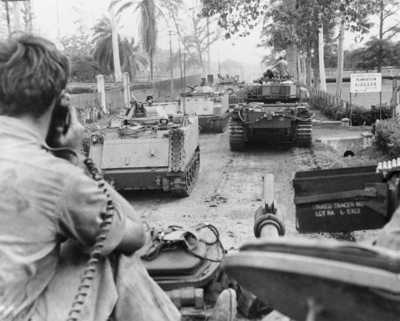
AWM BEL/69/0389/VN. Binh Ba. Centurion tanks from 1st Armoured Regiment, and armoured personnel carriers (APCs) from B Squadron, 3rd Cavalry Regiment, move along the main road of the village past Plantation Gallia. Armour together with infantry dislodged a strong North Vietnamese Army (NVA) group which had entered the village.
By 1.30 pm, crewman on three of the four tanks had been wounded, tank ammunition had been expended and relief by Sergeant Jock Browning’s troop was welcomed. Major Blake’s infantry force dismounted, reformed on the western end of the village and at 2 pm swept through again using similar tactics to the morning’s. It was now obvious that each house had a bunker below in which enemy had escaped detection during the initial sweep. After each tank/APC had fired into a building, the infantry entered and hand-to-hand fighting increased in tempo.
Paul Stevens found himself without any artillery tasks because of the close fighting and describes how the command vehicle had collected a platoon commander who had been wounded when he came face to face with a VC on entering a house. The officer had then survived a grenade blast before dispatching the enemy with a shot from his rifle.
The courage and leadership of junior ranks was superb. Of the 21 rifle sections involved, twelve were commanded by private soldiers. Two platoons were led by sergeants and one by a corporal. By last light, the assault force had completed this second sweep and were exhausted. Major Rein Harring’s B Company 5 RAR had moved into a blocking position south of the village during the day and the battalion’s commanding officer, Lieutenant Colonel Colin Khan had been in a forward tactical headquarters at a village just to the north of Binh Ba since noon.
Attention now focussed on the gun end of 105th Field Battery in Nui Dat which began receiving incoming rockets at about 7.30 pm. Gun Position Officer, Lieutenant Arthur Burke recorded the nearest landing some 60 m from one field gun and another 100 m from the ammunition dump. The mortar locating radars obtained a fix on the enemy’s firing point and the gunners manned their guns in retaliation. The enemy ceased firing but as the battery began to clean up after an hour’s firing, B Company 5 RAR reported a contact and the guns opened up in support. That evening a huge harassing and interdiction target list was handed down to the 105th which kept the gunners busy all night.
At 6 am next morning, 7 June, B Company to the south of Binh Ba engaged an enemy force of company strength after first mistaking them for friendly Vietnamese soldiers—at first both sides waved to each other! As D Company now prepared to sweep through Binh Ba village in a final clean-up, some 80 enemy were observed in a rubber factory at Duc Trung, 1000 m north. A Vietnamese reaction force assisted by elements of 5 RAR were tasked but the enemy slipped out of the noose.
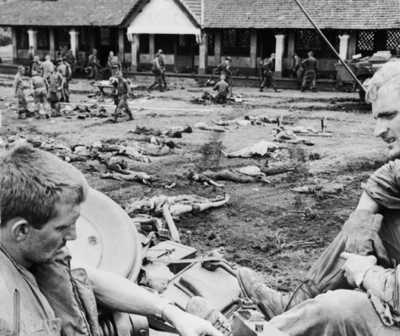
BEL/69/0388/VN. Binh Ba, South Vietnam. June 1969. Bodies of dead North Vietnamese Army (NVA) troops who attempted to hold the rubber plantation village are laid out in an open area so they can be checked for documents before burial.
D Company began its sweep from the west. The gruelling tasks of bringing out the dead and searching them for documents, accepting the surrender of wounded enemy, relieving hiding civilians, and stockpiling captured weapons and ammunition made for a slow and distasteful process. The macabre scene of the day was the enemy dead in the village square, laid out under the District Chief’s orders for a salutary warning to villagers not to harbour the enemy. One bright spot in this day were papers which identified the enemy as a battalion of NVA regulars who had been trying to sneak across Phuoc Tuy Province to a sanctuary in its northeast. D Company was not surprised that they had been regulars, but were very relieved at the outcome of the battle.
About 1 pm, heavy firing broke out around Duc Trung village to the north and the District Chief reported that the RF platoon had been overrun by about 100 enemy. Artillery fire was brought down amongst the withdrawing enemy on the northern edge of the hamlet whilst helicopter gunships assisted in containing them till B Company 5 RAR with four tanks arrived within 20 minutes. The southern part of Duc Trung was then secured, but the enemy was so intermingled with the civilians in the north that it was agreed RF troops should conduct the sweep of that area. Artillery and Bushrangers continued to harass the withdrawing enemy. Arthur Burke at the gun end of 105th Battery wrote, ‘We’ve fired more rounds in the last 48 hours than the first 20 days of last month -- 2000 rounds’. B Company blocked northwest of Duc Trung that night.

These are the times that try men’s souls. T Paine. From The Year of the Tigers, edited by Captain MR Battle, 1970. p56.
D Company completed its clearance of Binh Ba at 5.15 pm and went into a night blocking position in the rubber to the south-west of the village. Despite expectations of an NVA return, the night was mercifully peaceful. Paul Stevens described it as ‘deliciously cool, and the lanes of rubber trees stretched as far as the eye could see. From the outside, even the village looked peaceful.’
The Battle of Binh Ba or by its military name, Operation HAMMER concluded at 8 am on 8 June after a final sweep of the village. An hour later, Australian Civil Affairs personnel arrived to guide and assist the resettlement of the villagers. Task Force Commander Brigadier Sandy Pearson and Lieutenant Colonel Colin Khan spoke with the weary but proud troops prior to their return to base.
The words of a presentation at the Royal Australian Infantry Corps Conference in 1981 aptly summarise this operation.
The contact at Binh Ba was characterised by vicious hand to hand fighting of an intensity rarely equalled during our period in Vietnam. The close support of the tanks was vital in allowing infantry to enter and clear houses. Engagements were at close quarters requiring high volume, short-range fire … Binh Ba was a magnificent example of close cooperation between infantry and tanks against a determined, dug-in enemy.
In this vicious battle, a large enemy force was defeated by rapid reaction, skill, courage and firepower. The Battle of Binh Ba is well credited in the 5 RAR book, The Year of the Tigers as ‘one of the major military victories of the Australian Force in Vietnam’. However, whether it was triggered as an ambush or by accident remains a mystery.
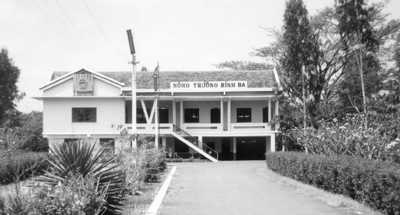
Binh Ba 1995, Communist Party Office. (Photograph courtesy Denis Casey.)

Binh Ba in 1995. (Photograph courtesy Denis Casey.)
Colonel Arthur Burke, a keen military historian is currently the Colonel Commandant of the Royal Regiment of Australian Artillery in Queensland. This article amalgamates the bibliography with his and Major General Paul Stevens’ personal diaries from 1969 when they were fellow subalterns in 105th Field Battery RAA in Vietnam. It should be noted that, whilst not specifically for Binh Ba, but including their actions at that time, the following received awards: Lieutenant Colonel Colin Khan—Distinguished Service Order, Major Murray Blake and Captain Ray De Vere and 2nd Lieutenant Brian Sullivan—Military Cross, 2nd Lieutenant Peter Rogers—Distinguished Flying Cross, Sergeant Brian London—Distinguished Conduct Medal, and Corporal Peter Strudwick—Military Medal.
The author is indebted to Paul Stevens, Ray De Vere and Bruce Cameron for their constructive editorial comments on drafts of this article.
Battle, Capt M.R. Ed, The Year of the Tigers, 5th Battalion The Royal Australian Regiment, Sydney, 1970.
‘Heritage—The Battle at Binh Ba—Operation HAMMER—South Vietnam 6-8 June 1969’, ‘Ironsides—The Magazine of the Royal Australian Armoured Corps’, Combat Arms, No. 2 1983, Phoenix Defence Publications, Canberra, pp 3–10.





